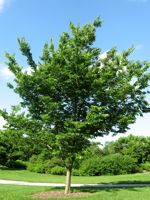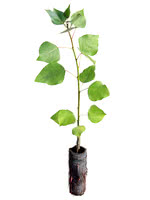Mon-Fri 9am - 5pm Mountain time
Common Hackberry vs Quebec Poplar
Celtis occidentalis
Populus x P38P38
CUSTOM GROW
The Common Hackberry is a medium-sized deciduous tree that resembles the American Elm but is immune to Dutch Elm Disease. They are versatile and can adapt to a variety of growing conditions.
It produces purple-red, berry-like fruit with a large seed in the center. Both the sweet flesh, which tastes similar to dates, and the crunchy seed are edible. The fruit remains on the tree throughout the winter, offering a valuable food source for birds and other wildlife.
The Common Hackberry can also be a great addition to a pollinator garden. The tree itself is a host for the larvae of several butterfly species and the flowers provide a source of pollen and nectar.
A hybrid of Simon's Poplar and Balsam Poplar, Quebec Poplar is a fast-growing deciduous tree. This particular selection was one of the finalists for the Quebec Ministry of Forest's Hybrid Poplar breeding program.
It is useful for quickly establishing a privacy screen or as part of a shelterbelt, and prefers moist soil. Disease resistance is likely high as is cold hardiness.
Quebec is a province with a strong forestry sector and we are excited to be offering this variety.

